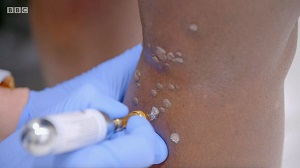Cryotherapy is a medical treatment that involves the use of extreme cold temperatures to freeze and destroy abnormal or diseased tissue. It is commonly used in dermatology for various purposes, including the removal of skin lesions, treatment of certain skin conditions, and pain management. Here are some key points about cryotherapy:
- Procedure: Cryotherapy involves the application of a cryogen, such as liquid nitrogen, to the targeted area. Liquid nitrogen is extremely cold and can reach temperatures as low as -196 degrees Celsius (-321 degrees Fahrenheit). The cryogen is typically applied using a spray, cotton swab, or a specialized device.
- Applications of Cryotherapy in Dermatology:
- Lesion Removal: Cryotherapy is commonly used to remove benign skin lesions, such as warts, skin tags, seborrheic keratoses, and actinic keratoses (precancerous lesions). The freezing temperatures destroy the targeted tissue, causing it to slough off over time.
- Skin Cancer Treatment: Cryotherapy can be employed to treat certain types of skin cancer, including basal cell carcinoma and squamous cell carcinoma. It is most suitable for superficial or small lesions.
- Skin Rejuvenation: Cryotherapy techniques like cryofacials or cryo-massages are sometimes used for cosmetic purposes to improve the appearance of the skin, reduce inflammation, and promote collagen production.
- Pain Management: Localized cryotherapy can be used to alleviate pain and inflammation in specific areas of the body, such as in the treatment of arthritis or sports injuries.
- Advantages and Considerations:
- Non-invasive: Cryotherapy is a non-surgical procedure that does not require incisions or anesthesia in most cases. It can be performed in an outpatient setting.
- Minimal downtime: Following cryotherapy, the treated area may form a blister or scab, which will eventually heal and slough off. The recovery time is usually minimal compared to surgical procedures.
- Side effects: Common side effects of cryotherapy include pain, redness, swelling, and blistering at the treated site. These symptoms are typically temporary and subside within a few days or weeks.
- Multiple sessions: Depending on the nature of the condition being treated, multiple cryotherapy sessions may be required for optimal results.
- Precautions and Professional Expertise: Cryotherapy should be performed by a trained healthcare professional, such as a dermatologist, who can assess the appropriateness of the treatment for your specific condition. They will consider factors such as the location, size, and type of lesion, as well as your overall health and medical history.
It’s important to consult with a qualified healthcare professional to determine if cryotherapy is suitable for your specific needs. They can provide a proper evaluation, explain the procedure in detail, discuss potential risks or complications, and develop a personalized treatment plan tailored to your individual circumstances.
Reveal Your True Glow
Unleash your skin’s true potential and reveal a radiant glow. Our clinic specializes in providing personalized treatments for a variety of skin concerns. Our skilled dermatologists will carefully assess your specific needs and create a customized treatment plan tailored to address your unique concerns. From nourishing skincare products to rejuvenating procedures, we offer a comprehensive range of options to help you achieve healthy, luminous skin.

